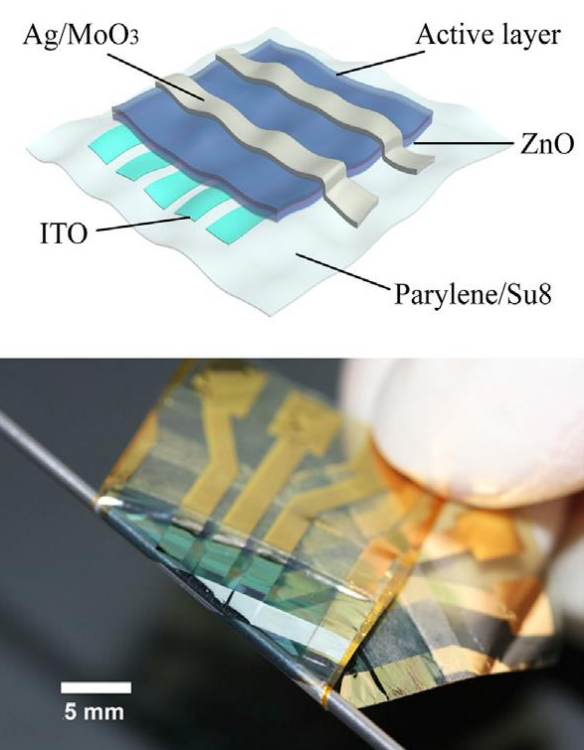

Next-gen wearable electronic devices
Ultra-flexible electronics has many potential applications within areas such as for example the military, healthcare and energy. Stretchable organic solar cells (OSC’s) has the potential to provide a promising power source for next generation wearable electronic devices. However, it is still a challenge to produce OSC’s that concurrently have a robust mechanical stability and can achieve high efficiencies due to the fact that aggregated microstructures and high crystallinity are thought to be critical for facilitating highly efficient devices but tend to leave the active layer brittle and hence nonflexible.
Our research

Schematic of the ultra-flexible organic solar cell (top) and photograph of the ultra-flexible organic solar cell. The free-standing device is wrapped over a syringe needle (bottom)
Researchers from Monash University’s Department of Materials Science and Engineering, University of Tokyo’s Department of Electrical Engineering and RIKEN have recently produced an ultra-flexible 3m thick (10 times smaller than the width of a human hair) OSC which delivered a world leading power conversion efficiency during strain and stretching testing.
The research group utilised a polymer donor and a mixed fullerene / non-fullerene acceptor to enhance charge separation and transport and to optimize the morphology of the active layer with more amorphous regions. This enabled the researchers to make a very thin electronic device which behaved exceptionally well during strain and stretching testing. The OSC which achieved a power conversion efficiency of 13% exhibited a 97% retention of the PCE after 1000 bending cycles with a bending radius of 0.5mm and an 89% retention of the PCE after a 1000 cycle compression-stretching test with a 45% compression and a bending radius of 10µm.
The research team utilised amongst other a technique called near edge X-ray absorption fine structure (NEXAFS) spectroscopy at the Soft X-ray beamline to investigate the chemical composition and morphologies of the activelayer both at the top and bottom surface of the thin film device and it was found that the molecular alignment of the film exhibit a face on stacking configuration which favours charge transport across the active layer.
Our impact
The reduction of crystallisation in the active layer by introducing a mixed acceptor is an effective way to make more robust devices which can undergo significant mechanical stress and strain without losing its efficiency. The Australian Synchrotron played a key role in the investigation of this ultra-flexible organic solar cell.